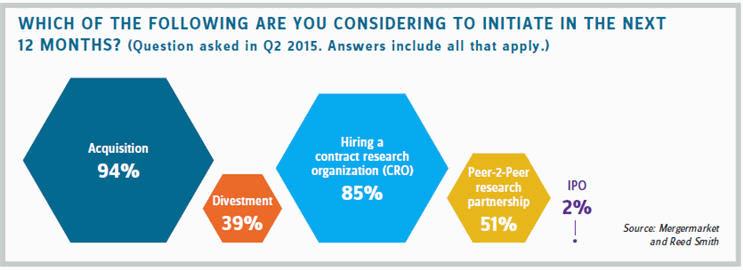9 Biotech Valuation Enhancers: Preparing For Big Pharma Due Diligence
By Brian Daniels, M.D., strategic advisor and Don Therasse, M.D., strategic advisor, YourEncore
Mergers and acquisitions are an important growth strategy for many life sciences companies looking for new agents to strengthen or complement an existing portfolio, enter a new market, or replenish an expiring patent, among other reasons. According to a global study conducted in Q2 2015 by Mergermarket and Reed Smith, 94 percent of senior life science executives planned to make an acquisition in 2016, so biotech firms need to do everything possible to make sure they are properly positioned to get the most value for their asset.
In our former roles at Bristol-Myers Squibb and Eli Lilly & Company, we evaluated hundreds of potential assets to add to our portfolios. Now that we’ve graduated from Big Pharma and are consulting or doing venture investing, we are frequently asked by biotech companies for advice on what Big Pharma is looking for in potential partners or acquisitions, and how biotechs can put their best foot forward

If you want to attract more suitors and maximize the valuation of your asset or company, the first rule is to do good science. This is a given. After that, follow these nine rules:
1 KNOW THE BUYER LANDSCAPE. In addition to understanding your product and data, you should also understand how your asset fits into your potential partner’s portfolio and strategy. Are buyers looking to build on a strength or fill a gap? Are they looking to add or mitigate risk in their portfolio? The stronger the fit, the higher the valuation will likely be.
2 PRESSURE TEST THE DATA. Blind spots are a big issue for any size organization, so it’s important to critically examine your data and get an external perspective before you get it from your potential buyers. Having an external expert perform a detailed, objective assessment and ask the tough questions will help you identify blind spots and develop a road map to address issues before you engage with potential suitors.
3 ADDRESS SHORTCOMINGS HEAD-ON. Pharmaceutical development is incredibly challenging, and every asset or development program has its flaws. So don’t try to hide or minimize those deficiencies; instead, acknowledge and address them head-on. Any attempt to hide or mask deficiencies will eventually be uncovered, and will result in damaged credibility, loss of trust, and suspicion that there are more surprises yet to be found.
4 IDENTIFY A SPEEDY AND EFFICIENT PATH TO PROOF OF CONCEPT. As with all drug development activity, the greater the certainty, the higher the value. For early-phase assets, a biotech that is well on its way to demonstrating clinical proof of concept is a much more attractive partner than one that still has a way to go.
5 ASSESS HOW DATASETS ARE STRUCTURED. Keep in mind that ultimately all safety data related to your asset will have to be integrated for submission to regulatory authorities, and in most cases that will require electronic transfer of the data to the acquiring company’s safety database. Especially for later-stage assets with large and fragmented datasets, this assimilation of safety data can present a significant (and expensive) challenge to your partner. Just as poorly organized data can have a negative impact on negotiations and valuation, wellstructured datasets can be a significant positive.
6 MANAGE THE NUMBER OF DEVELOPMENT PARTNERS. It may be tempting to hire a host of CROs to speed up the development process; however, more partners means more data sources to assimilate. For late-phase assets this will mean a complex network of datasets and a nightmare for acquiring life sciences companies. As you go through development, keep the end in mind and carefully manage the number of development partners you use.
7 HAVE YOUR INTELLECTUAL PROPERTY HOUSE IN ORDER. One of the biggest and most time-consuming challenges for your pharma partner during the due diligence process is often sorting out the IP and freedom-to-operate status of your asset. Before getting into discussions with a potential partner, engage with an IP attorney to ensure everything is in order.
8 THINK BIGGER. Once you have interest from a potential partner and understand its portfolio and strategy, think carefully about additional ways your asset can add value. Are there additional indications or combinations that could be pursued? Look at immediate and future applications, and paint scenarios for them. The more a biotech can think about how they can bring value to the acquiring company, the more the partner will understand how it can fit the asset into its longer-term portfolio/enterprise strategy.
9 BE TRANSPARENT DURING VALUATION. When valuing your company, it’s extremely important to be transparent about your assumptions. Show exactly how you arrived at your valuation so both sides can sit down and reconcile their term sheets. Remember, there will always be dialog and negotiation. Knowing exactly what the starting point is for each party will create greater understanding and a much more cordial environment and efficient process.
